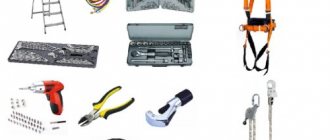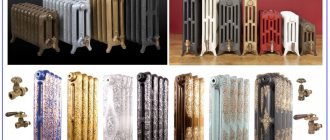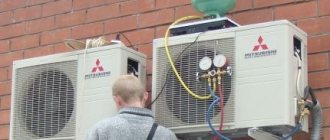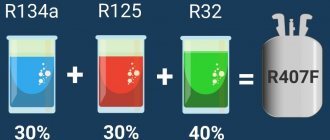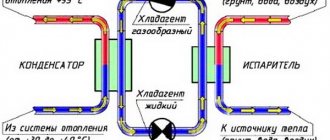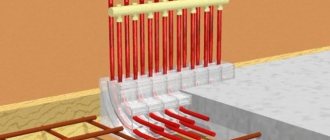List of main components and parts that make up any air conditioner:
- printed circuit board for control and indication
- temperature sensors (thermistors)
- remote control
- filters
- electric motors and fan impellers
- service and 4-way valves
- contactors and relays
- thermostats
- capacitors
Air conditioner device
The operation of the device is based on the ability to absorb heat during evaporation and remove it through condensation. Let's take a closer look at how this procedure occurs in a split system.
Air conditioner circuit diagram
The main components of this unit are:
- Compressor.
- Evaporative element.
- Thermoregulation valve.
- Fans.
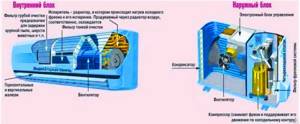
Coolers used
Household climate control systems are filled with refrigerants of different brands. These are inert chemicals, their second name is freons. In Russia, until 2015, R22 was used to refill air conditioners. Now its use is prohibited. Chlorine and bromine, which are found in R22, negatively affect the Earth's ozone layer.
Now some manufacturers refill refrigerators and split systems with R 410A. This freon does not harm the environment. It contains no chlorine and boron. Freon R134A is current. It is non-toxic, non-flammable, and is used in automobile and household air conditioners.
| Refrigerants with high ozone depletion activity | Refrigerants with low ozone depletion activity | Ozone-safe refrigerants |
| R11 | R21 | R717 |
| R12 | R22 | R143A |
| R113 | R123 | R125 |
| R114 | R124 | R32 |
| R115 | R23 | |
| R502 |
External unit
The air conditioner consists of an indoor and outdoor module, the latter is located outside the building. This is caused by the noisy operation of the fan and compressor, as well as the independent removal of warm air into the atmosphere.
Outdoor unit design
Despite the variety of air conditioners, their external module always has the same components:
- Compressor. It is capable of compressing freon and imparting a certain movement along the contour.
- Capacitor located in the outdoor unit. It turns the refrigerant into a liquid state.
- Evaporator. The radiator is located inside the device - it serves to convert freon from the watery phase to the gaseous state.
- Thermostatic valve (TRV). The device reduces the refrigerant pressure.
- Fans. The task of these devices is to blow air over the evaporator and condenser to create more intense heat exchange with the atmosphere.
- Filters. These parts of the air conditioner protect the circuit from foreign particles (dirt, dust)
IMPORTANT! When the air conditioner operates in warm air injection mode, the external module is equipped with a four-way valve, which is controlled from the internal module. It is responsible for changing the supply modes of warm and cold air flow.
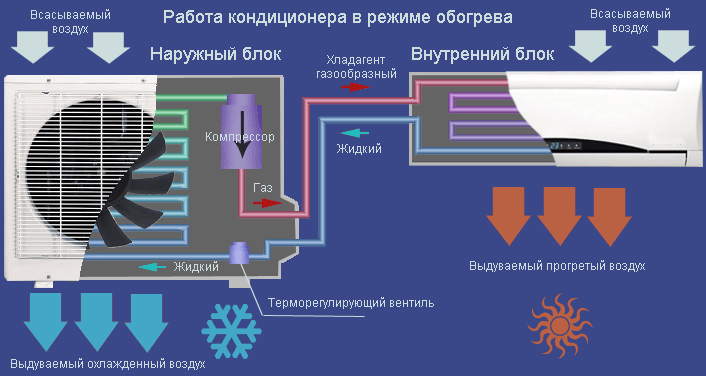
Air conditioner operation in heating mode
Installation features

For the outdoor unit to function as required, it must be installed correctly. It is better to entrust this task to professional installers. To check their operation, pay attention to the following nuances:
- The brackets must be of high quality, made of durable material. Find out the weight of the outdoor unit and only then select brackets based on this characteristic. Consult the store before purchasing;
- The block should be installed at a distance of 20-30 centimeters from the wall, no closer;
- The location of the block also plays an important role. The further the outdoor unit is from the indoor unit, the further the route with communications will have to be laid, which will subsequently complicate maintenance;
- The unit can be installed on the façade, above ground or on the roof. If installed on the roof, provide bird protection. When installing on a facade, it is important to consider where the condensate will drain. Often, a thin tube is removed from which water flows out. Make sure that it does not flow onto your neighbor’s window sill or balcony.
Indoor unit
An indoor air conditioner is necessary to provide cool air in the room. The design of this unit allows you to take in air from the street and distribute it evenly in the room. In this regard, the main elements of the internal structure are:
Radiator (evaporator). It received this name because during the cooling stage freon evaporates in the tubes, and the principle of operation of the circuit is based on this phenomenon. The power of the unit largely depends on the size of this device: the larger the air conditioner, the larger the evaporator should be.
It is an interlacing of tubes with plates that increase the plane of heat transfer. The refrigerant moves through the capillary vessels at a certain speed and temperature.
Fan (impeller, shaft). To quickly cool the room, it is necessary to force the air flow through a cooled radiator. This is where this impeller helps.
For many models, the evaporator outlines the fan configuration, thereby making the installation of the internal module compact. This creates effective circulation of air masses.
Fan motor . It is attached with a special bracket to the module box and serves to rotate the impeller.
Drainage bath . During operation of the air conditioner, condensation forms on the radiator. And this tray exists to collect it. In addition to moisture, it collects dust, dirt and other foreign particles. Therefore, for better care, this device is removable.
Vertical and horizontal blinds. These elements move from small motors and are attached under the drainage tray. At the same time, horizontal curtains regulate the air flow up and down, and vertical ones - left and right.
Command block . This microcircuit is a board to which all significant starting elements of motors and sensors are connected through wires.
Coarse filter . It looks like a plastic mesh to which small particles of dust, dirt, and wool stick. This filter needs to be cleaned once every two weeks to avoid overloading the engine.
Maintenance and care
In standard operating mode, the external unit requires a preventive inspection as part of maintenance once every 6 months. The technician inspects the fasteners, checks the integrity and level of contamination of the filters, specifies the amount of refrigerant and measures the operating pressure of the networks.
The greatest difficulty during maintenance is replacing the working fluid.
Refrigerant is a chemical that poses a health hazard, so you should trust a professional to work with it. You can check the condition of the filters and remove dust and dirt yourself.
Air conditioner operation
All components of the unit are connected to each other by copper tubes and thereby form a refrigeration circuit. Freon circulates inside it with a small amount of compression oil.
The air conditioner allows you to perform the following process:
- The compressor receives refrigerant from the radiator at low pressure of 2-4 atmospheres and a temperature of about +15 degrees.
- When working, the compressor compresses freon to 16 - 22 points, due to this it heats up to +75 - 85 degrees and enters the condenser.
- The evaporator is cooled by a flow of air having a temperature lower than that of freon, as a result of which the refrigerant cools and transforms from a gas into a watery state.
- From the condenser, freon enters the thermostatic valve (in household appliances it looks like a spiral tube).
- When passing through the capillaries, the gas pressure drops to 3-5 atmospheres, and it cools, while part of it evaporates.
- After the expansion valve, liquid freon enters the radiator, blown by an air flow. In it, the refrigerant is completely converted into gas, takes away heat, and therefore the temperature in the room decreases.
Then the freon with low pressure moves to the compressor, and all the work of the compressor, and therefore of the household air conditioner, is repeated again.

Air conditioner operation in cold weather
Split system functionality
Modern models can operate in different modes:
- Heating. The function can be used at low but positive temperatures outside, when the heating in the building does not work for some reason.
- The ventilation mode operates due to the operation of the evaporation module fan. The function is recommended to be used when warm air accumulates in the ceiling space. Due to ventilation, air masses can be evenly distributed throughout the room.
- Air drying. The function is used without reducing the room temperature. Excessive moisture remains on the evaporator and is discharged outside through the drain pipe.
- Air filtration from dust, wool and other debris.
The following options can be provided to manage the system:
- temperature programming;
- operation in automatic mode;
- night shutdown function;
- timer;
- self-diagnosis (by function one can judge the operating mode of the key mechanisms of the unit).

Many air conditioners have the following additional functions:
- Possibility of adding fresh air. The function allows you to reduce the concentration of carbon dioxide in the apartment.
- Winter equipment allows the system to function even at low temperatures (usually down to minus 20 degrees).
- . A very convenient, although rare, feature. The sensor detects the location of a person’s presence and signals the unit to direct a stream of cold air slightly to the side. Thus, using the air conditioner becomes more comfortable, because Cold air will no longer blow directly into the lower back or head. If the sensor does not detect the presence of a person, then after a certain time the system switches to operation in economy mode.
- Controlling a household air conditioner using the Internet or mobile phone.
Types of air conditioners
Manufacturers produce all types of air conditioners, investing heavily in their business. As a result, a modern consumer can choose any model according to any parameters.
Air conditioners split systems
Split type devices are great for small rooms.
ON A NOTE! Based on installation, units are divided into floor, window, wall and ceiling air conditioners.
There are two types of such devices: separation systems and multi-dividing systems. Wall-mounted split system units consist of two blocks: a small internal unit and a large external module.
The external device contains the loudest devices. A multi split system is formed by combining several indoor units into a single outdoor module. This allows you to optimally preserve the design of the house.
Ceiling type air conditioners
In rooms with a large area, as a rule, units for installation on the ceiling are chosen. Their advantage is that the cooled air is evenly distributed horizontally throughout the room without directly affecting people.
A massive ceiling-type air conditioner is almost invisible, and it is indispensable when extensive air flow is needed to the most remote parts of the room, while the jet length in some models reaches up to 55 meters.
There are also duct and cassette ceiling air conditioners. In this case, the first devices are completely hidden behind a suspended ceiling or in a channel, and the second type - cassette blocks have the form of ceiling tiles measuring 600x600 mm.
Split system
Although the disconnect system consists of indoor and outdoor modules, its operating principle is no different from any other type of domestic ceiling air conditioner.
The housing of the external unit itself contains a heat exchanger, a fan and a compressor. Additional elements of the split system are a dryer, expansion valve and connecting pipes.
And also to connect the unit to the electrical network, it contains the necessary starting and control devices.
Industrial air conditioners
Such devices are developed to serve areas of more than 350 meters and therefore they have a number of features, thereby differing from household air conditioners. The design of precision equipment may vary.
They are often installed in houses where a special microclimate is needed for each room - shopping centers, banks, hotels. Industrial air conditioners are divided into the following systems:
Multizone devices. These VRF and VRV air conditioning units include up to 64 indoor modules and up to three outdoor units. In total, they are located on communications up to 300 meters long.
It is possible to set a separate temperature for each indoor module and provide its own microclimate in each room. The error in the set temperature is only 0.05 degrees.
"Chiller fan coil" . Devices with this system differ in that not freon is used inside the circuit, but water or antifreeze. The central refrigeration unit is called a “chiller”, and the heat exchange elements are called “fan coils”.

Chiller-fan coil circuit 2
The advantage of such a unit is that the distance between these components can be any, since water flows through ordinary pipes.
Central and rooftop air conditioners. These devices are varied in their action. They are used in the form of heat exchange units, fans, air purifiers and humidifiers.
It is called central because the air mass is processed in the indoor unit and then moves through pipes through the rooms. Installation of air conditioners of this type and installation of communications is particularly complex and requires an external source of cold.
If possible, it is better to choose roof monoblocks, which are easier to install.
Main settings
When choosing and purchasing an external unit for a split system, you need to pay attention to four main characteristics:
- Size, height, width, length.
- Power.
- Noise.
- Length of highways.

The dimensional dimensions of external units depend on the power and functionality of the equipment.
Average dimensional characteristics of the outdoor unit of a split system:
- width 80 cm;
- height 50 cm;
- thickness 30 cm.
Models offered on the market may have different capacities. It all depends on the purpose of the equipment. A standard household split system has a power that can cover a space of up to 100 square meters. m.
An important characteristic of the external unit is noise. If the indoor air conditioner operates without noise, the external unit can cause significant inconvenience to the neighbors. When choosing a model, it is better to clarify the noise level produced during operation of the external unit. The permissible value is 32 dB.
It is also necessary to pay attention to the permissible length of connecting lines between blocks.

The distance stated in the technical data sheet of the model must not be exceeded, as this may lead to a serious reduction in the efficiency of the equipment.
Air conditioner malfunctions
Today's climate control equipment is equipped with a warning function about possible breakdowns. You just have to decipher the diagnostic information.
The unit does not turn on
This is the most common breakdown of an air conditioner and probably every user has encountered it. These problems usually occur due to the electrical part:
- The device is not connected.
- The command chip is faulty.
- There is no connection between the outdoor and indoor units.
- The control panel does not work.
- The circuit breaker has tripped.
- Incorrect switching when sending signals.
And finally, the device may fail due to simple wear and tear of parts.
Switching off the split system after a short period of operation
This phenomenon occurs due to overheating of the compressor, as well as due to a breakdown of the protective relay. The unit heats up due to contamination of the radiator on the external module.
In such cases, preventative cleaning of the grille should be carried out. And also after refueling, the balance in the radiator and condenser circuits may be disrupted.
Condensate leak from the indoor unit
In the summer, owners of air conditioners may experience overflowing of condensate containers. The reason for this may be freezing of the heat exchanger, which should be insulated. If leakage appears at the joints, then you need to tighten the nuts. If the drainage tube becomes clogged with dirt, it should also be cleaned.
The air conditioner is not working at full capacity
This type of malfunction occurs mainly in the summer. The device consumes a large amount of energy during operation, but is not able to provide the required temperature conditions. The reason here most often lies in dirty air filters.
ATTENTION! Although thin purifiers, ozonizers, and ultraviolet light lamps improve the air, they also significantly affect the cost of the unit.
Smells
If an unpleasant odor begins to appear from the device, there are several reasons for this. If there is a burning smell, you need to check the wiring, and it is recommended to do this at service centers.
When the stench gives off dampness or mold, it means that a colony of bacteria has formed inside the unit. You can get rid of it with the help of an antifungal drug.
What is the outdoor unit attached to?
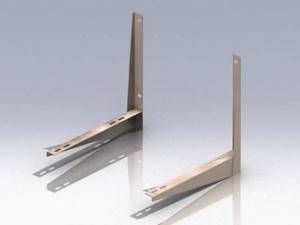
During installation, the external module must be secured. For standard fastening of the block to the wall of a building, brackets consisting of two welded strips are used. They are usually made from durable profiles of different sections. They have two holes for mounting to the wall and two for installing the air conditioner itself. Such fasteners can withstand loads several times greater than the weight of an average block.

air conditioners on stands
To install the device on the roof, floor, or ground, use universal stands for the outdoor unit of the air conditioner, which are made of metal and coated with powder paint. They are attached to the surface through welded holes using frame-facade fasteners and have sliding strips that can be adjusted to any size of the device. As a rule, the stand for the outdoor unit of an air conditioner can support more than 250 kg, which corresponds to the weight of a very powerful industrial unit.
The benefits and harms of air conditioning
Pros of the device
The main advantage of air conditioners is that they create a microclimate suitable for humans in the room. This, in turn, increases labor productivity, improves mood and well-being.
Therefore, the main advantage of this air conditioner is the creation of favorable conditions for work or leisure. The main task of such units is to lower the temperature during hot periods and heat the air during cold periods.
In addition, installing air conditioners in service centers or in Internet rooms allows you to avoid premature breakdowns of computer equipment due to overheating.
And also some models of such units are capable of performing several more useful functions:
- Purifying the air space from unpleasant odors. For example, window air conditioners are often installed in the kitchen and toilet.
- Humidification or dehumidification of indoor air.
Disadvantages of devices
However, if the air conditioner is used incorrectly, it can cause certain harm to human health:
- There is a possibility that these devices may harbor harmful bacteria.
- Climate control equipment favors the spread of viruses.
- Air conditioners, passing air through themselves, kill useful elements in it.
- Compressors create noise during operation.
In fact, in most cases, this refers to myths, and such statements are not true. To avoid unpleasant phenomena, you do not need to be under a cold stream of air flow.
Systematic cleaning of the unit and its preventive repairs will help avoid improper operation of the device. And if you follow these basic rules, the air conditioner will create a pleasant microclimate in the room, which is so necessary for a person to have a pleasant rest and fruitful work.
How to calculate the required air conditioner power?
It is accepted that 1 kW of cooling power is sufficient up to 10 kW. m of room with a ceiling height of up to 3 m. To obtain more accurate results, use the formula:
Q=S*h*q, where Q is the heat inflow in kW, S is the area of the room in m2, h is the height of the room in m, q is the intensity of exposure to the sun (the room is illuminated - 40 W/m3, average - 35 W/m3 , weak – 30 W/m3).
To the resulting value add 0.1 kW for each person who will be in the room and 30% of the rated power of the electrical appliances operating in the room.
Car air conditioners... or refrigerators?
Remove the air conditioning in the summer, the interior becomes hot, drivers turn on the heater in the summer heat, forcing forced cooling of the car engine. The oncoming flow carries away the excess energy of the horsepower of the pistons. Many people have to undress.
Humanity is failing to grasp the need to reuse resources. It is powerless to create spacecraft where regeneration systems will take a leading role. Imagine what a wonderful (eternal) ship planet Earth will become.
Why does a car need freon?
The radiator cools the engine; a small proportion of models contain a condenser, necessitating the need to remove heat. 150 grams of excess freon increases the pressure by 10 atmospheres, the pipes simply burst due to excess if the car is stationary. Refilling the refrigerant is carried out by a special technician with diagnostic equipment, a person who purchased an emergency Diagnostic kit for air conditioning systems.
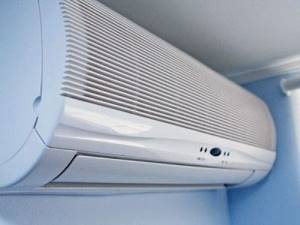
A typical refrigerator operates by generating four states of freon. Reason for choosing the substance! Perkins created an ice maker that circulated ethyl alcohol ether. Later they used ammonia and other toxic stuff, then freons appeared. Relatively safe (to humans), some varieties have exploded under certain conditions. It is still relevant for household refrigerators, the concentration of the substance is so low that an instant release of 100% of the volume into the dining room is powerless to cause an emergency.
The difference between freon: the refrigerant easily changes the state of aggregation between liquid and gas. A huge amount of heat is absorbed/released, making the principle of operation of a mobile air conditioner possible.
Car air conditioner: principle of operation, service measures
The car is different. The work is controlled by four aggregate states of freon:
- Compression.
- Condensation.
- Extension.
- Evaporation.
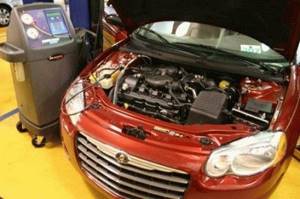
There are four devices inside the car that allow freon to complete the cycle:
- Compressor.
- Condenser (condenser).
- Receiver-dryer.
- Evaporator.
The operating principle of the air conditioning compressor is the same, excluding the operating requirements. The condenser and evaporator are coils. The latter carries a fan. Know: the car uses the NoFrost option, do not be afraid of frost falling in the cabin, the moisture will settle on the evaporator. The workshop, using ultrasonic generators, can easily remove settled bacteria and microbes from the coil. Unlike the NoFrost refrigerator, the principle of operation of a car air conditioner involves periods of idleness, microscopic organisms have time to multiply outrageously.
In working condition, the temperature is maintained at minus 5 ºС, the living thing waits for favorable circumstances. Only in the salon you can smell rot (smells like fungus), it’s time to refresh the atmosphere of the salon.
Now the air conditioner evaporator becomes a carrier of infection, adversely affecting health. Mold can feed on anything, grows, and releases a bunch of harmful substances that envelop the comfortable driver’s seat. You cannot completely get rid of the spores floating around; ask the car service center to carry out disinfection.
Mentioned above, an ultrasonic generator is used to evaporate the antiseptic liquid at room temperature. Thick steam reaches the tract of the switched off air conditioner, killing the living microflora inside, which produces an unpleasant odor.
There are four physical states of freon. The compressor compresses freon gas, pumping it into the condenser: the refrigerant gives off heat to the air flying past. The coil is located in front of the hood; the oncoming flow creates forced cooling of the device. There is often a receiver-dryer nearby. The element frees the system from moisture, expands freon, and the evaporator pressure drops sharply. Makes the process of selecting interior energy possible. The fan blows on the evaporator, the temperature next to the driver drops.
Why remove water from your car air conditioner?
The receiver-dryer of a household refrigerator frees the freon passing by from water. Stop doing this, an ice plug will form at the outlet of the element, which will damage the strained roaring compressor. The air conditioner stops performing its functions, freon stops circulating along the circuit. The dehumidifier is represented by a thick tube with absorbent poured inside. The balls stick together over time, ceasing to perform their functions, and it’s time to send the car air conditioner for repair.
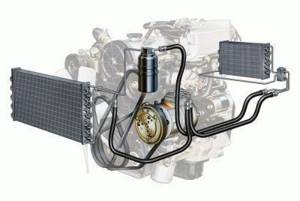
Car air conditioner repair
We mentioned the Diagnostic kit for assessing the condition and repairing a car air conditioner. The kit contains a filling cylinder and a pump for pumping air out of the system. According to science, in household refrigerators, refilling the refrigerant is accompanied by replacing the filter. The saving master is freeloading, the moisture will let you know.
Before pumping in new freon, a search is made for system leaks. Otherwise, the fresh refrigerant will have a long life. If the integrity of the copper tubes is in order, the old freon is removed from the system with a special vacuum pump. The intricate network of tubes is cleared of air and water vapor. Becomes possible thanks to the phenomenon discovered by Guericke and Boyle (XVII century):
- Under vacuum conditions, water evaporates at low temperatures.
It's warm outside the workshop. Having received a vacuum, the system becomes pristinely clean, ready to accept new freon. Afraid of making a mistake with the mass, the filling cylinder is placed on a special scale, counting out the required amount. The refrigerant is replenished through a special service valve. The tanker sees: the required mass of freon has been filled, the process can be completed. Testing is underway. Repeated manipulations with the leak detector will allow you to assess the presence of holes in the updated system. Absent, the repair process is considered completed.
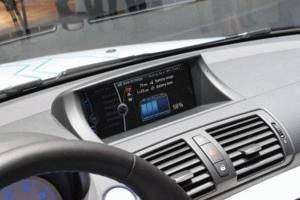
We know that there are a lot of copper and steel pipes in the refrigerator; the principle of operation of the air conditioner in a split system will allow you to make do with flexible hoses. Hoses are vulnerable to ruptures. However, advanced workshops are equipped with special hydraulic crimpers for crimping joints. The force developed is not inferior to a good-quality jack. The created connection satisfies the system requirements.
Operation of a car air conditioner for heating
We are used to taking away the heat of the engine, which stinks of burnt rubber. Today's solutions provide for the reverse mode of operation of on-board equipment. The principle of operation of an air conditioner for heating is to change the direction of the freon current in the opposite direction. We don’t think that car systems are much different from household ones; the trick is implemented by a four-way valve that switches the input and output of the compressor in places. An asynchronous motor easily changes the direction of rotation; this fact is not enough to obtain the desired mode.
The developers decided: it would be easier to use a four-way valve. All that remains is to wait until they fit into the cabin a device that implements the principle of operation of a precision air conditioner, helping to maintain the temperature values recommended by doctors of 18 - 22 ºС with an accuracy of tenths. Humidity will be adjusted, avoiding drying out food (see NoFrost refrigerators)! While precision air conditioners are found in data centers of large companies, there are powerful servers that perform functions day and night.
It is high time to introduce inverter control circuits. Welders use their technical gifts and are praised when welding aluminum using argon. Non-ferrous metals take only alternating voltage. The principle of operation of an inverter air conditioner: the engine rotation speed is regulated by the frequency of supply pulses. Allows the equipment to operate in a lighter mode, extending its service life.
Let's look at the principle of operation of an air conditioner without an air duct later, today we say goodbye. We hope you liked the information about automotive equipment and will find it useful for those carrying out regular maintenance.
Repairing an air conditioner with your own hands: is it worth it?
Avoid fiddling with freon. Difficult to buy, refilling is impossible at home. It is necessary to withstand the pressure of the system, avoiding causing dysfunction of the device. A smart indication will tell you about breakdowns. More often, the alarm is formed by LEDs that light or blink in a fixed sequence. Each type of air conditioner breakdown is accompanied by a specific code.
You will find split systems that display information on an LCD display or control panel. There is a self-monitoring function launched by holding the power button (optional). It turns out a failure code, as happens with washing machines. Each manufacturer provides its own fault detection mechanism. Read more in the operating instructions or on the company's website. Typical air conditioner breakdowns are also indicated there. Of course, cases arise that the manufacturer wisely keeps silent about. It is recommended to read forums dedicated to air conditioners.
System operation

All parts of the air conditioner (except for fans) are connected to each other using thin copper tubes. In some devices, the tubes are made of aluminum. A coolant (most often freon) circulates through the tubes inside the air conditioner. The coolant takes either gaseous or liquid form. Fans protect the system from overheating.
When vaporous freon enters the compression hole, it has a temperature of about 10-15 degrees. Its pressure is 4-5 atmospheres. The refrigerant is compressed in the compressor, the pressure increases 5 times, and the freon temperature rises to 90 degrees.
Very hot freon enters the condenser. There it cools, releasing heat, and smoothly turns into a liquid state. Next, the freon passes through the choke and enters the evaporator. Here the liquid agent is mixed with the gaseous one. As it evaporates, it creates cooling. After this, the freon enters the compressor again, and the cycle closes. This is a simple diagram of how an air conditioner works.
